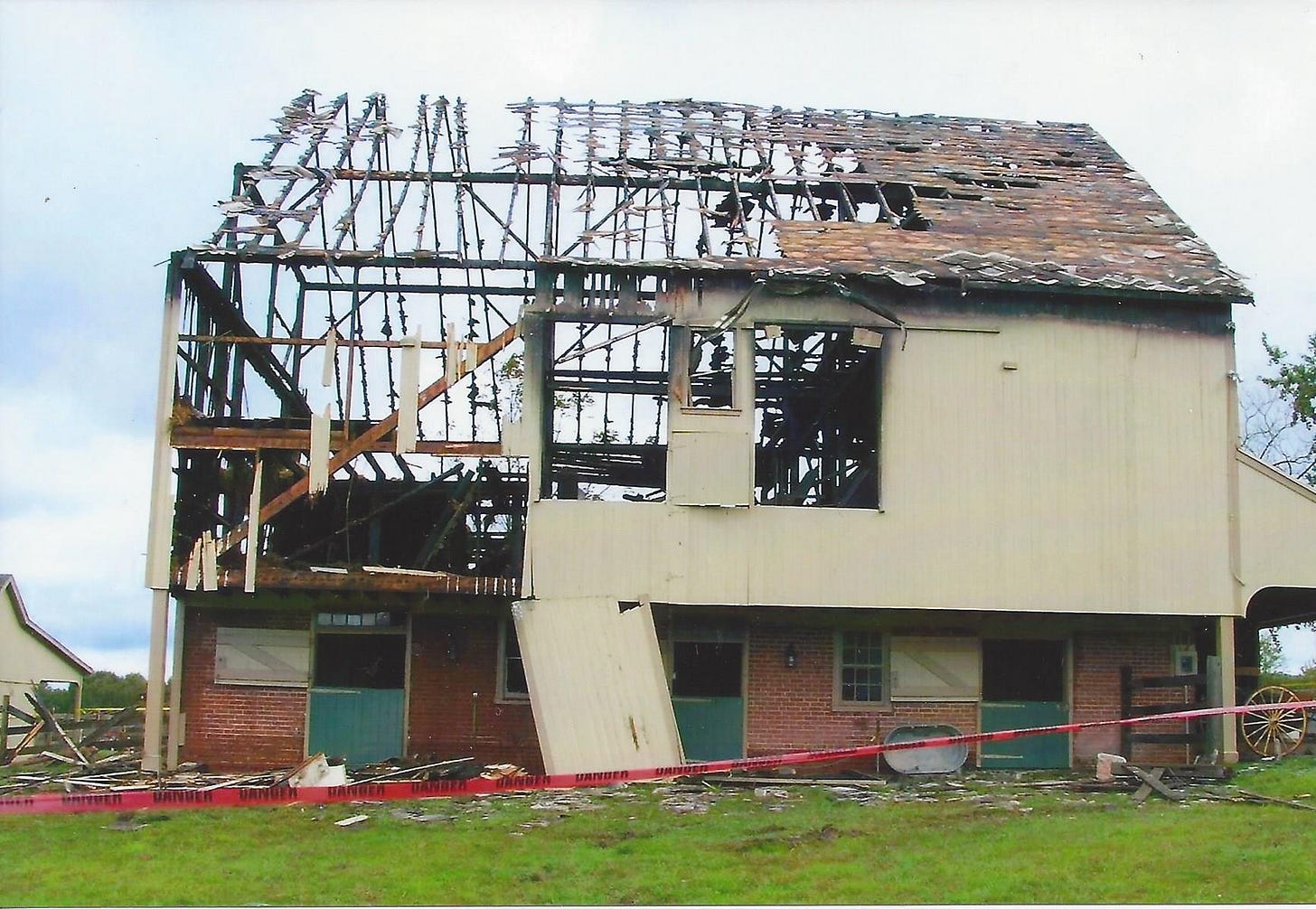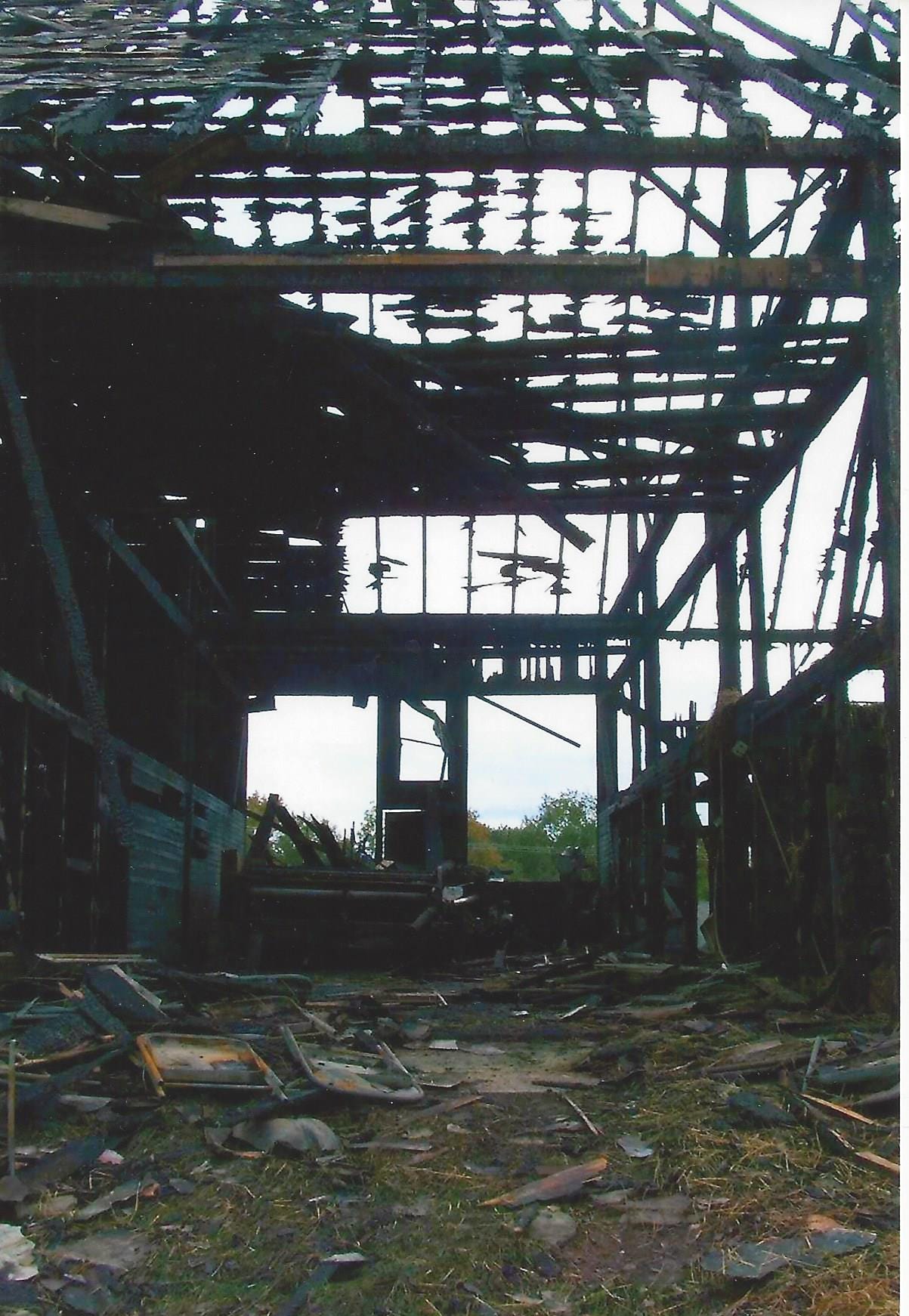What a lightning bolt taught me about mental health
Takeaways from my bout with anxiety
A few years ago, the phone rang during a thunderstorm on a random September night. When my husband picked up, the neighbor across the road relayed a terrifying message–“Your barn’s on fire.”
My husband charged down the stairs, and for the first time in my life, I dialed 9-1-1. Lightning had struck our barn. The dispatcher told me the fire had already been reported and the firefighters were on their way. Though they would arrive in minutes, it already felt like our disaster had been in progress for an hour.
When I went out to check that my husband wasn’t doing anything foolish before the firefighters arrived, I found the puny kitchen fire extinguisher he’d tossed on the ground when he discovered the situation was already well beyond him. As I bent down to pick it up, I felt what was either the heat from the fire or the terrible shock of primal fear on the back of my neck.
I deliberately avoided getting a look at the actual fire because I feared seeing it would only provide enhanced visuals for the nightmares I anticipated in the weeks to come. I retreated into the house to stay with our girls, who were 4, 6, and 8 at the time.
Not long after the firefighters arrived, one knocked on the door to say that, while he thought we were going to be okay, it would be best if I woke the kids and got them out of the house, along with any important papers, just in case.
We summoned both sets of parents, and when my in-laws arrived, I sent the kids home with them because if our house was indeed going to burn down that night, there was no good reason for the children to stand there and watch it happen. Then there was nothing left to do but stand there on the front lawn, holding my mom’s hand for the first time since I was 5, waiting to see whether the inferno would spread.
In total, six fire companies would respond that night. Later we’d hear that people had gathered on a hill about half a mile away to watch the conflagration.
Though officially it took only an hour for the firefighters to get the fire under control, thanks to 250 bales of hay, they were on scene for hours trying to extinguish the fire for good.
Fortunately, no one was injured, and the fire never spread to our house. When the firefighters left just after 2 a.m., the horrific event was over, but we had just turned the page to the next chapter of the trauma.
Although I knew that far worse tragedies could have befallen me, I was shaken to my core. Previously, when I’d heard about a family safely fleeing a house fire on the news, I classified those people as lucky, thinking they had escaped harm. What I didn’t realize, but was about to discover, was that trauma causes wounds even when your body escapes unscathed.
Though I was 40 at the time of the fire, neither I nor anyone close to me had any experience in seeking professional mental health help. And yet never before had I felt so vulnerable, anxious, and completely separated from my normal state of mind. I knew I needed help. I was about to get a crash course in dealing with a mental health condition.
At the time, I didn’t realize how common mental health issues were. According to the stats, one in five American adults experiences a mental health condition in any given year. About half of Americans will meet the criteria for a diagnosable mental health condition sometime in their lives.
Even if you are enjoying good mental health, as my experience shows, that can change in an instant. And even if you don’t experience a mental health issue, it’s likely that at some point, a friend, family member, or colleague will.
We could all benefit from being better informed about mental health matters. So, I’d like to observe Mental Health Awareness Month by sharing my key takeaways from navigating my way through post-traumatic stress and anxiety.
Mental fortitude and prayer alone aren’t always enough to get anybody through anything
I was raised by parents who taught me that hard work and persistence helped you achieve goals and overcome any problems you encountered. We were big on being self-reliant.
I also believed that a loving God was watching over me, and that a whole communion of saints in heaven was ready and willing to help if I prayed and asked for assistance.
While I still believe in a healthy amount of self-reliance and the power of prayer, my mental health crisis also taught me that it’s sometimes necessary to seek outside help from professionals trained to help deal with mental health conditions.
When someone has a mental health issue, they should seek professional help without any sense of shame about it at all.
After all, you see a doctor when you have a physical ailment that you can’t treat on your own. When you have a mental ailment, you should likewise seek professional help.
If you’re trying to assess whether you or someone you know needs an assist, this 1:48 video from the National Alliance on Mental Illness (NAMI) describes 10 Common Warning Signs of a Mental Health Condition.
If you’re having a mental health crisis, immediate help is available
The day after the fire, my husband insisted that we walk around the full perimeter of the fire scene to take in all of the destruction before the girls returned home. The lower level of the barn was unscathed, but the roof and three walls of the barn were gone. The charred timbers that were left were enough of a spectacle that every passing car slowed down to gawk.
Our barn wasn’t the only thing reduced to ashes. The peace of mind that I had previously enjoyed was shot to hell, and I had no idea how I was going to get it back. In fact, I wasn’t sure how I was going to be able to keep living in our house anymore.
The day after the fire, I called the hotline of my husband’s employee assistance program. I spoke to one of the mental health counselors, who did what she could to calm me down. It was clear to both of us by the end of our conversation that I needed additional help. But at least it was a start.
If your employee benefits include access to an employee assistance hotline, this is an excellent resource.
Alternatively, if you or someone you know needs immediate assistance, here are two options to keep in mind:
The 988 Lifeline offers free, confidential help 24/7/365. Just call or text 988, or visit their website to chat. (Their website even accommodates the deaf and hard of hearing.)
The NAMI Teen & Young Adult HelpLine is available Monday through Friday, 10:00 AM - 10:00 PM ET. Text Friend to 62640 to immediately connect with a Teen & YA Specialist. Call 1-800-950-NAMI (6264) to speak with a Teen & YA Specialist. Or visit their website to chat.
Finding a therapist takes a little work, but it’s not impossible
Sure, it can be challenging to find an in-network therapist who’s accepting new patients. But I would characterize it as one of those pain-in-the-ass tasks that takes a little legwork rather than a significant obstacle.
I prioritized finding a therapist near me with an open slot relatively soon. I got an appointment within a week of the fire.
This Step-by-Step Guide to Finding a Therapist from Life Kit walks you through everything.
Medication may help, but it might not be enough on its own
I had difficulty sleeping and found myself incredibly on edge in the days after the fire. So I made an appointment with my family doctor, who prescribed some anti-anxiety medication.
Though the pills didn’t magically dissolve my anxiety, they helped. I found they were most effective for helping me get to sleep and for mellowing me out if a thunderstorm was about to roll through. (The distant rumble of thunder was enough to trigger a fear that we were in imminent danger of another catastrophe.)
However, it was clear that pills alone weren’t going to fix things for me.
My experience tracks with what Dr. Meg Jay, a developmental psychologist who specializes in treating 20-somethings, has noted: “There are very few mental health disorders for which medications ought to be the first step in treatment–and there are no mental health disorders that are best treated with pills alone.”
Since your mileage may vary, I highly recommend you consult your doctor or therapist to assess the particulars of your condition.
“Talk therapy” doesn’t offer an immediate cure, but it can help if you give it a chance
Cognitive behavioral therapy (CBT) is a structured, goal-oriented type of “talk therapy” that can help manage mental health conditions, such as depression, anxiety, and emotional concerns, such as coping with grief or stress.
It would have been ideal if my anxiety had improved soon after I began seeing my therapist, who confirmed a diagnosis of post-traumatic stress disorder. But it typically doesn’t work like that.
Recovery was a process that took a while. Part of what helped me to heal was practicing the skills that the therapist taught me for dealing with an episode of anxiety.
I still dreaded seeing the little thunderstorm icon on a weather forecast for a while. And I still felt uncomfortable during a thunderstorm, but at least I had some tools in my toolbox for dealing with my anxiety. Putting these coping mechanisms into practice and surviving what initially seemed like “moments of peril” ultimately helped me to get better.
It takes time, but recovery is possible
The spring after the fire, we rebuilt our barn. When the cupola with a copper weathervane that served as a lightning rod was hoisted into place atop the barn, most people probably thought it signaled that we had completely recovered from our misfortune. Although I wish that were the case, it wasn’t entirely so.
Though we were able to rebuild the barn within months, it took longer than that for me to fully recover emotionally from the fire. In fact, for several years, I did not go a day without thinking about the fire and its aftermath at least once.
But I did recover. Gradually, a combination of practicing the coping skills I learned in therapy, time and distance from the traumatic event, support from others, and grace helped me to heal. I no longer suffer from anxiety.
There’s a misconception that once someone develops a mental health condition, they can never recover. As my experience demonstrates, people do indeed recover.
And even when a mental health condition is chronic, there are ways to manage it and professionals who can help.
How could I tell when I was finally over my trauma? For a while after it happened, if I told somebody the story of the barn fire, I’d emphasize how bad it was by saying that I would give anything if the barn fire had never happened. Then, eventually, one time when I told my story, I stopped before I said my “give anything” because it had begun to dawn on me how many good things might not have happened if we hadn’t been through the fire.
Learning about mental health and how to support people who are dealing with a calamity was certainly one of the most worthwhile things that came out of the barn fire. Here’s hoping that sharing my story and the message that you should never be afraid to seek, or to encourage someone to seek, mental health help when necessary, is another.








